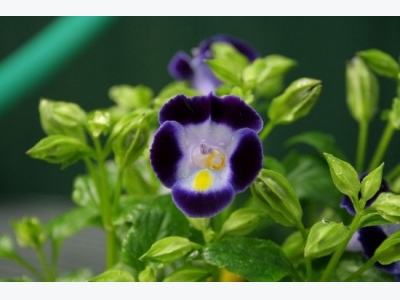How to Grow Torenia

Impatiens are the obvious choice for most when it comes to a favorite annual flowering shade plant. To deviate a bit this year, try torenia. Torenia, also known as the wishbone flower or bluewings, is a cute and perky companion or alternative to the old stand-by.
Torenia produces flowers from early summer to fall. Their cool colors will brighten up your shady nooks or crannies. Their long lasting blooms and trailing nature will also make your ground containers or hanging baskets pop. They are beautiful tucked in rock gardens and set along pathways.
Torenia are native to Africa and Asia. They belong to the snapdragon family, which gives them a playful quality. Their nickname, "the wishbone flower," comes from the shape of their stamens. When you gently squeeze the flower petals apart, you can see the stamens. They curve together into the shape of a wishbone.
Most often blue, torenia are also found in shades of pink, yellow, purple, and white. They are usually 8 inches tall and about 6 inches wide. While they prefer hot and humid conditions, torenia can be grown in most regions. There isn't any reason not to give these sweet little show-stoppers a try this growing season.
Growing Torenia Flowers
Torenia is easy to grow. It takes a bit longer than most other plants to germinate, so it should be started indoors from seed 10 to 12 weeks before the last frost. Start the seeds in rich compost soil. Cover the seeds lightly and be careful not to bother the roots when watering the tiny starts.
For a bushier plant, nip off the growing tip of the plant to encourage branching when your seedling is about 3 inches tall.
You can buy torenia at your favorite nursery or garden center, too. Transplant your home-grown or store-bought seedlings outdoors after the threat of frost has passed. Prepare your outdoor soil with a thin layer of sand to increase the soil's water drainage. Place your transplants 6 inches apart.
Water your torenia often enough to keep the soil around the plant moist. Place an inch of mulch underneath your plant and maintain that layer throughout the growing season to keep the moisture in the roots of your torenia. Don't let the soil become dry, but avoid allowing soggy soil, too.
Every month, feed your soil a nice compost to keep your torenia blooming bountifully. Also, pinch off the dying bounty of blooms each week to make room for new growth.
To grow torenia in containers, use a rich, well draining soil. Water often enough to keep the soil moist. Torenia is beautiful all by itself in a container, or it can be paired with another shade tolerant plant such as perilla. The perilla provides a dramatic backdrop of deeply colored foliage for the bold green foliage and colorful flowers of the torenia.
If you really love torenia, and would rather not be without it at the end of the growing season, torenia can be grown as a houseplant. Treat your indoor torenia to the indirect but bright light of a north or east facing window. Keep your soil moist, just as you would for your outdoor torenia. Feed your indoor plant monthly with a fertilizer high in phosphorous. This will support your plant's ability to bloom.
Torenia Pests and Problems
Torenia is generally a stout little plant. Its pest-free and problem-free nature makes it all the more lovable. Mold and rot are its most common problems. Proper watering techniques and good spacing for air circulation will avert these issues.
Torenia Varieties to Try
'Large Blue' is a hardy, drought tolerant variety that blooms early. Its blooms last throughout the season.
'Midnight Blue' is a rare "true blue" flower variety. Birds and hummingbirds love this one.
'Pink' is a bright, happy variety that is sure to tickle-you-pink.
Related news
 Common Diseases of Pecan Trees
Common Diseases of Pecan Trees Pecan trees (Carya illinoinensis) are as beautiful as they are useful – growing 75 to 100 feet with a wide spreading canopy.
 How to Grow Lamium
How to Grow Lamium Looking for a fast-growing, attractive ground cover for shady areas? Consider lamium (Lamium maculatum), sometimes known as spotted dead nettle.
 How to Grow or Eradicate Horsetail Plant
How to Grow or Eradicate Horsetail Plant Horsetail plants are high in silica and have a gritty feel. Pioneers – and even campers today – used the plants to scour pots and pans.